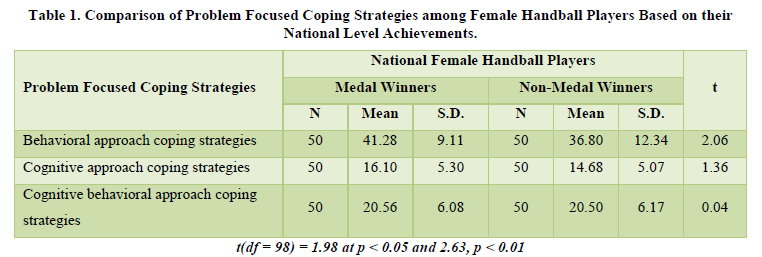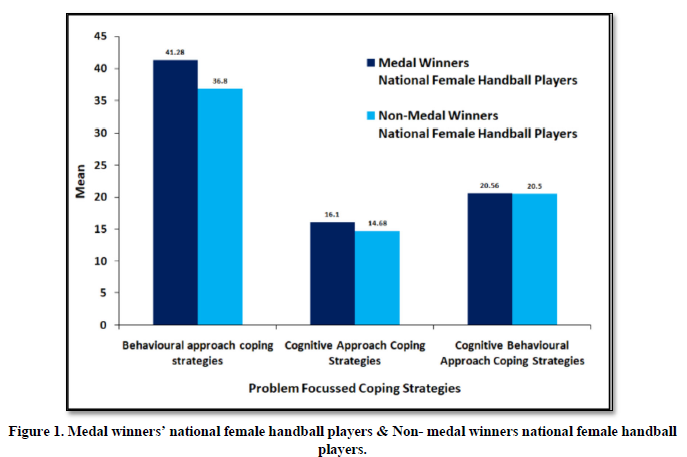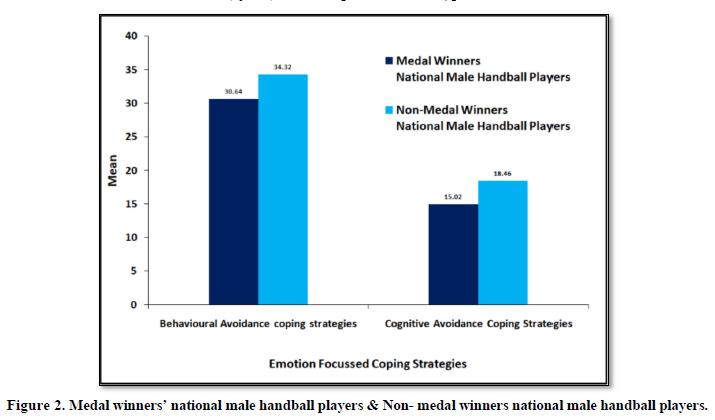INTRODUCTION
Physical and emotional tension is considered as feeling stressed. Stress may be due to some annoying circumstances by which we get aggressive or anxious or even frustrated. Stress is the reaction to a challenging situation or demand expressed by our body. The stress of short duration may help an individual to meet certain deadlines but when stress becomes permanent or last for too long then it is a cause of worry. Short-term or acute stress is not uncommon but when it becomes chronic, it needs to be managed properly otherwise it reduces our performance and can have an ill effect on our health. The source of stress in sportspersons is injury, the expectation of coaches and spectators, the decision of the referee, competitive pressure and arguments/disagreements with coaches and trainers. These are the most common sources through which an athlete experience or feels stress (Abedalhafiz et al., 2010). Kroshus (2014) believe that the non-sporting factor may also cause stress in sportsperson and that may include family issues, relationship with loved ones, social factors and work pressure. The sports-related factors include fear of failure in major tournaments, unfamiliar environmental conditions when playing away games, ambiguity in team tactics, unrealistic goals and lack of communication or social support. Stress be it acute or chronic needs to be managed through certain strategies and for that the term coping is used. Coping means adjusting or tolerating actual realities by the use of some strategies. Coping strategies are classified by psychologists. Folkman & Lazarus, 1984 divided coping strategies into four segments, (1) problem focused, (2) emotion focused, (3) support seeking and (4) meaning-making. Weiten, 2008 described coping strategies in the form of adaptive cognitive coping strategies, problem focused coping strategies or adaptive behavioral coping strategies, emotion focused coping strategies and occupation focused coping strategies. Coping skills can be constructive or maladaptive. In problem focused coping strategies, an individual's main objective is to remove the source of stress or change its nature so that it is no longer stressful. Problem focused coping is adaptive because it meticulously gathers information and then evaluates the pros and cons of the action before implementing it in the best possible way. The emotion focused coping strategies comprise expressing suppressed emotions, controlling aggression, escape avoidance, self-blame and positive reappraisal. In sports researchers like Campen & Roberts, 2002; Gaureay et al., 2002; Giacobbi & Weinberg, 2000 have conducted extensive research regarding coping and they concluded that it is an essential part of sports performance and without which the sportspersons become too stressed and inevitably it affects their performance. Bernard & Lindsey, 2004 also opined that assessment of coping in sports is primarily based on problem focused vs. emotion focused coping strategies.
Handball as a competitive Olympic sport encompasses complexities and the players are bound to get stressed just like any other sport. To excel at the highest level it is essential to have a proper coping mechanism and the present study evaluated the coping strategies used by medal winner and non-medal winner female handball players with national-level participation.
REVIEW OF LITERATURE
Kronhe & Hindel (1988) in a survey study on table tennis reported that cognitive avoidance coping strategies are best to enhance the probability of winning in a tiebreak.
Ptacek et al. (1994) in a study reported that females are more inclined to use avoidance coping strategies while males prefer problem-focused coping strategies to manage stress.
Pensgaard et al. (1998) evaluated the coping strategies used by Norweigian athletes selected for the Olympics. They found that athletes often use problem focused coping strategies not only to manage stress but also as a cognitive defense mechanism.
Biddle & Ntoumanis (2000) studied the relation between escape avoidance and behavioral detachment coping with anxiety in interuniversity athletes. It was reported that escape avoidance and behavioral detachment coping strategies often lead to increased anxiety in athletes.
Rouguli et al. (2006) evaluated the personality of junior handball players. It was found that the high-performing junior handball players possess superior characteristics such as emotional stability as compared to low-performing junior handball players.
Anshel & Sutarso (2007) in their study reported that players use approach behavior coping strategy to manage stress arising out of their relationship with coaches and trainers and when this coping strategy does not work then only they use other coping strategies to solve the problem.
Abedalhafiza et al. (2010) in their study identified factors such as illness, an argument with the coach, bad referring decisions, spectator behaviour, and too much aspiration of family and friends as major sources of stress in sportspersons and to control these stressors the sportsperson use approach as well as avoidance coping strategies.
Radochonski et al. (2011) in their study found higher usage of task-oriented coping strategies in highly successful athletes to manage stress and anxiety as compared to lesser-known athletes.
Kaplanova (2019) in their study reported that Ice hockey players' situation and stressor-specific coping skills thereby manage anxiety and stress levels properly so that higher levels of stress do not create hindrance to sports performance.
Kamarudin et al. (2022) in their study reported a positive and significant relationship between adaptive coping skills and the performance which includes both male and female athletes.
OBJECTIVE
The present study was conducted to compare coping strategies of medal-winner and non-medal-winner female handball players in national-level tournaments.
HYPOTHESIS
It was hypothesized that the coping strategies of national female handball players will differ significantly based on their sports achievements.
METHODOLOGY
The following methodological steps were taken to conduct the present study.
Sample
The sample for the present study was selected from national-level handball tournaments. To serve the purpose, 50 medal winner and 50 non-medal winner female handball players were selected purposively. The age range of the selected female handball players was 18 to 25 years.
Tools
Coping Strategies Scale
The coping strategies scale standardized by Srivastava, 2001 was thought appropriate for this study. This scale gives significance to five types of coping strategies namely behavioral approach coping strategies, cognitive approach coping strategies, cognitive behavioral approach coping strategies, behavioral avoidance coping strategies and cognitive avoidance coping strategies respectively. The scale consists of 50 items to assess the above five coping strategies. The scale is highly reliable with its concurrent and constructs validity proven through standard statistical measures. Interpretation of Scoring-Low scores on approach-behavioral, approach-cognitive and approach-cognitive behavior strategies means deficient coping. High scores on avoidance-behavioral and avoidance-cognitive coping strategies mean deficient coping.
Procedure
- The sample of 50 medal winner and 50 non-medal winner female handball players were drawn purposively from national-level
- Coping strategies scale Srivastava, 2001 was administered to these subjects in a peaceful Prior instructions were given before the administration of this scale.
- The items on the scale were scored as per instructions and summed according to respective 5 coping
- The scores obtained for each subject were then tabulated and placed in respective study
- Independent sample t test was used for data
RESULT AND DISCUSSION
A perusal of Table 1 indicates that the mean score on behavioral approach coping strategies for national female handball players with medal-winning credentials was 41.28. The mean score on behavioral approach coping strategies for national female handball players without medal-winning credentials was 36.80. The calculated t=2.06 denotes that preference for behavioral approach coping strategies was significantly higher in medal winner national female handball players as compared to non-medal winner national female handball players with a .05 level of statistical significance (Figure 1).


A perusal of Table 1 indicates that the mean score on cognitive approach coping strategies for national female handball players with medal-winning credentials was 16.10. The mean score on cognitive approach coping strategies for national female handball players without medal-winning credentials was 14.68. The calculated t=1.36 denotes that although the preference for cognitive approach coping strategies was higher in medal winner national female handball players as compared to non-medal winner national female handball players but it did not meet the criteria at p<.05.
A perusal of Table 1 indicates that the mean score on cognitive behavioural approach coping strategies for national female handball players with medal-winning credentials was 20.56. The mean score on cognitive behavioral approach coping strategies for national female handball players without medal winning credentials was 20.50. The calculated t=0.049 denotes that although the preference for cognitive behavioral approach coping strategies was higher in medal winner national female handball players as compared to non-medal winner national female handball players but it did not meet the criteria at p<.05.
Perusal of Table 2 indicate that the mean score on behavioral avoidance coping strategies for national female handball players with medal-winning credentials was 30.64. The mean score on behavioral avoidance coping strategies for national female handball players without medal - winning credentials was 34.32. The calculated t=1.39 denotes that although the preference for behavioral avoidance coping strategies was higher in non-medal winner national female handball players as compared to medal winner national female handball players but it did not meet the criteria at p(Figure 2).


A perusal of Table 2 indicates that the mean score on cognitive avoidance coping strategies for national female handball players with medal-winning credentials was 15.02. The mean score on cognitive avoidance coping strategies for national female handball players without medal-winning credentials was 18.46. The calculated t=2.49 denotes that the preference for cognitive avoidance coping strategies was higher in non-medal winner national female handball players as compared to medal winner national female handball players at p<.05.
DISCUSSION
The result indicates that the usage of problem focused coping strategies are higher in medal winner female handball players as compared to non-medal winner female handball players with both the groups formed from national level tournaments.
Result also indicate that the usage of emotion focused coping strategies are higher in non-medal winner female handball players as compared to medal winner female handball players with both the groups being formed from national level tournaments.
When stress occurs, an athlete thinks about the problem. After assessing it if an athlete feels that the problem can be solved and is controllable he uses problem focused coping whereas once he believes that the problem is beyond his reach he uses emotion focused coping strategies such as denial, distancing and escape avoidance. But avoiding a problem does not guarantee that stress will be reduced or controlled. It can come with a much more severe magnitude in future. In problem focused coping strategies an athlete directly encounters the problem so that the source of stress is eliminated and in future also the same stressor will not cause stress. In the similar lines Gaudreau et al. (2010) also reported that performance enhancement is the result of task oriented coping strategies.
CONCLUSION
The medal winner national female handball players more often than not use problem focused coping strategies to manage stress.
The non-medal winner national female handball players more often than not use emotion focused coping strategies to manage stress.
Abedalhafiz, A., Altahayneh, Z. & Haliq, M. (2010). Sources of stress and coping styles among student-athletes in Jordan universities. Procedia - Social and Behavioral Sciences, 5, 1911-1917.
Anshel, M. H., & Sutarso, T. (2007). Relationships between sources of acute stress and athletes coping style in competitive sport as a function of gender. Psychology of Sport and Exercise, 8, 1- 24.
Bernard, R., Lindsey L., Cohen, L. L., Catherine B., McClellan, C., B., et al. (2004). Pediatric Procedural Approach Avoidance Coping and Distress A Multitrait Multimethod Analysis, Journal of Pediatric Psychology, 29, 131-141.
Biddle, S. & Ntoumanis, N. (2000). Relationship of Intensity and Direction of Competitive Anxiety with Coping Strategies. The Sport Psychologists, 14, 360-371.
Campen, C., & Roberts, D. C. (2001) Coping strategies of runners: perceived effectiveness and match to precompetitive anxiety. Journal of Sport Behavior, 24, 144-161.
Gaudreau, P., Nicholls, A. R., & Levy, A. R. (2010). The ups and downs of sports performance an episodic process analysis of within-person associations. Journal of Sport & Exercise Psychology, 32, 298- 311.
Giacobbi, P. R., & Weinberg, R. S. (2000). An examination of coping in sport individual trait anxiety differences and situational consistency. The Sport Psychologist, 14, 42-62.
Kamarudin, F. A., Tajri, A. A., Bakri, N. H. S., & Lamat, S. A. (2022). Relationship between Coping Strategies and Sport Performance among Uitm Seremban 3 Athletes. International Journal of Academic Research in Business and Social Sciences, 12, 162-171.
Kaplanova, A. (2019). Self-esteem anxiety and coping strategies to manage stress in ice hockey. Acta Gymnica, 49, 10-15.
Krohne, H. W., & Hindel, C. (1988). Trait anxiety, state anxiety, and coping behavior as predictors of athletic performance. Anxiety Research, 1, 225-234.
Kroshus, E. (2014). Risk factors in the sport environment. In GT Brown Mind body and sport: Understanding and supporting student athlete mental wellness. Indianapolis IN NCAA. pp: 73-75.
Lazarus, R. S., & Folkman, S. (1984). Stress, appraisal and coping. New York Springer.
Pensgaard, A.M. & Ursin, H. (1998). Stress control and coping in elite athletes. Scandinavian Journal of Medicine and Science in Sports, 8, 183-189.
Ptacek, J.T., Smith, R.E. & Dodge, K.L. (1994). Gender Differences in Coping with Stress When Stressor and Appraisals Do Not Differ. Personality and Social Psychology Bulletin, 20, 421-30.
Radochonski, M., Cynarski, W.J., Perenc, L. & Siorek Maslanka, L. (2011). Competitive Anxiety and Coping Strategies in Young Martial Arts and Track and Field Athletes. Journal of Human Kinetics, 27, 180-189.
Rogulj, N., Nazor, M., Srhoj, V. & Bozin, D. (2006). Differences between competitively efficient and less efficient junior handball players according to their personality traits. Kinesiology, 38, 158-163.
Weiten, W. & Lloyd, M.A. (2008) Psychology Applied to Modern Life Wadsworth Cengage Learning.








